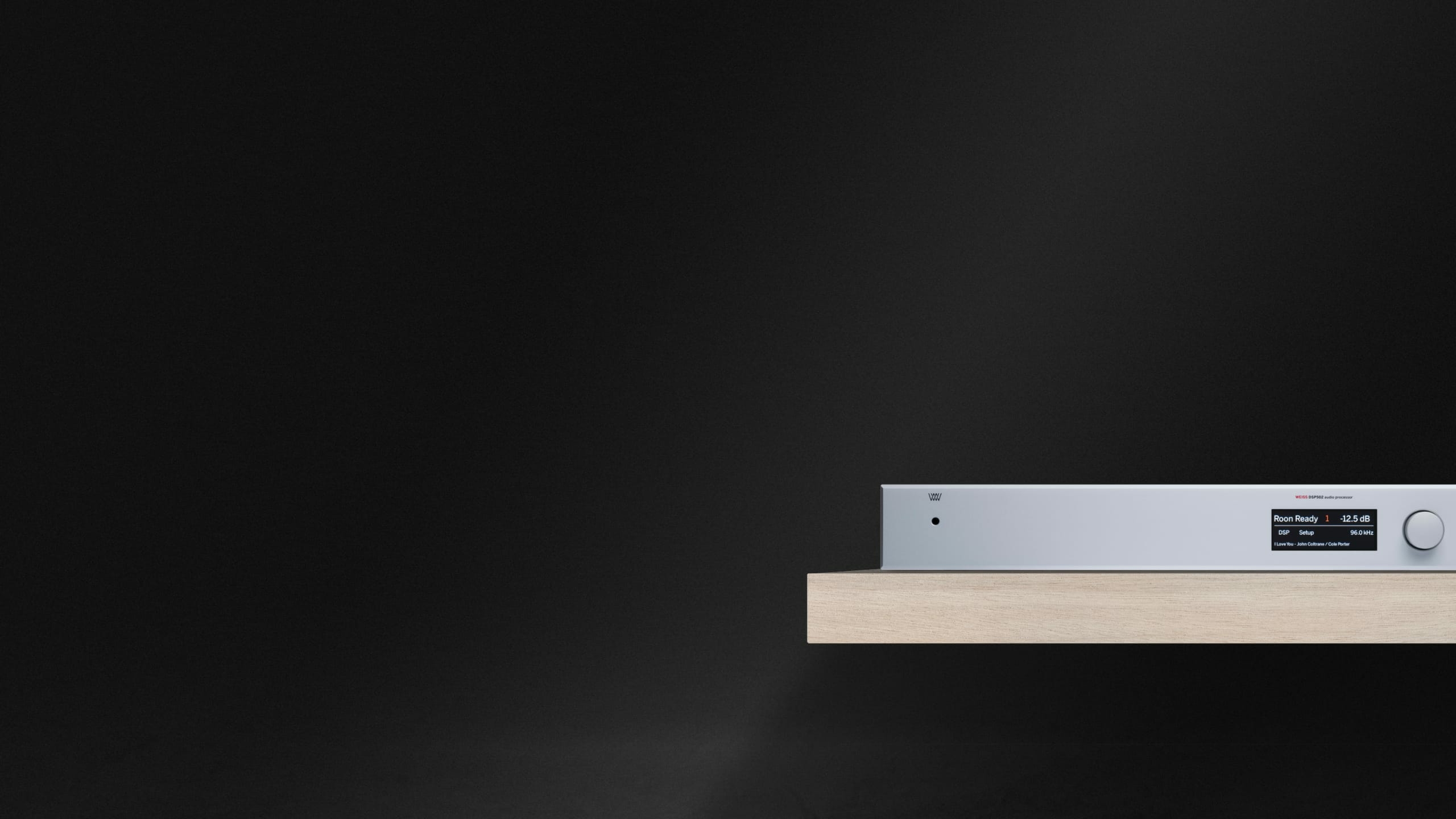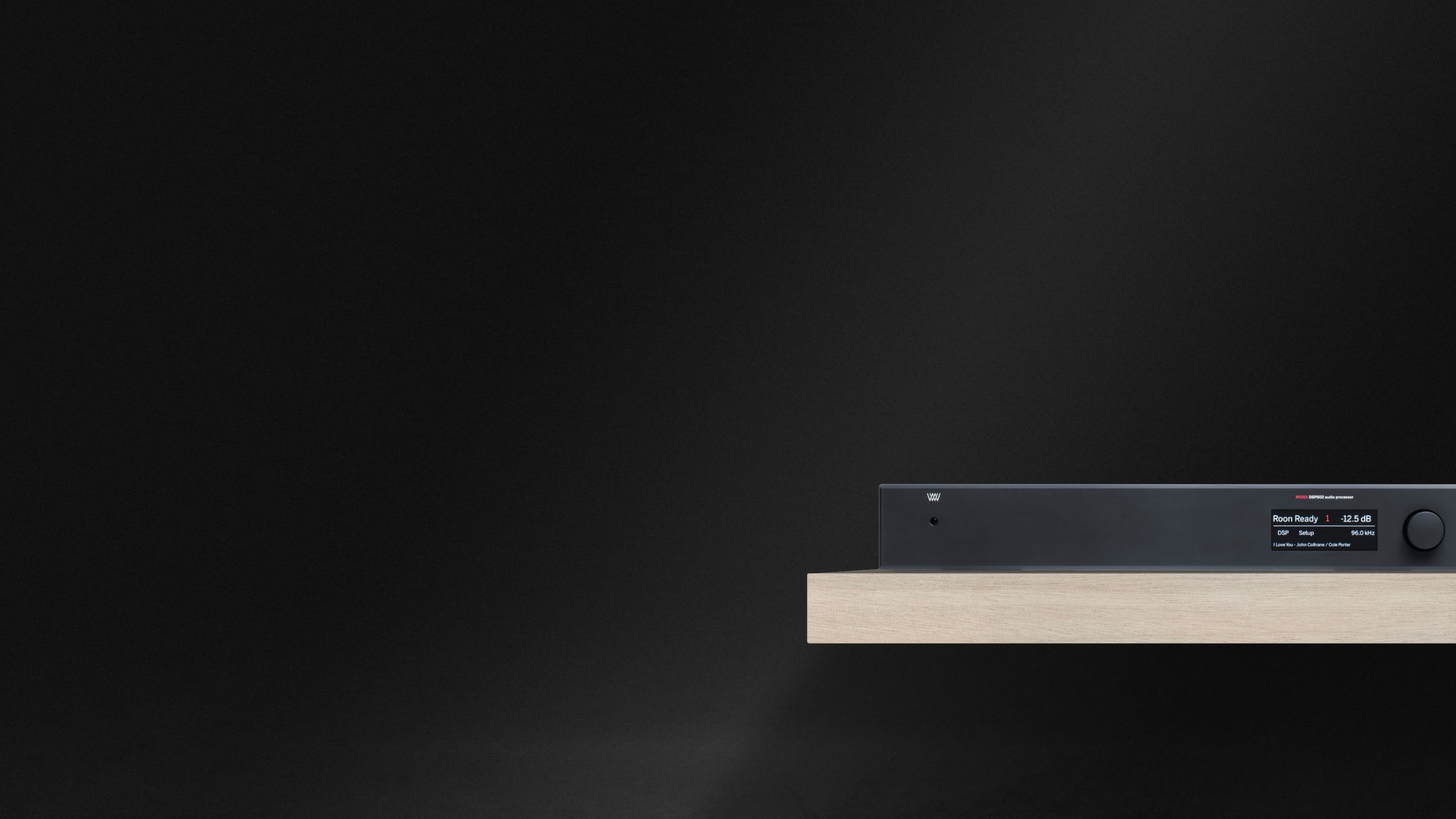MAKE GOOD SOUND EVEN BETTER
AUDIO PROCESSOR AND NETWORK RENDERER
Use the DSP502 to improve room acoustics and fine-tune loudspeakers’ frequency response. Or take things further and enhance less-than-perfect recordings to your taste. Reduce sharp sibilants, add creative EQ, emulate vinyl sound on digital recordings, and experience the magic of crosstalk canceling.
The DSP502 is a digital signal processor which treats the audio using the same quality algorithms that have made Weiss Engineering’s professional line of products indispensable tools in sound studios worldwide.
Main Features
Weiss DSP502



Technical Data
Weiss DSP502
There are a total of five inputs:
- AES/EBU or S/PDIF via XLR, Toslink, and RCA sockets.
- UPnP/DLNA via Ethernet.
- USB.
- Roon Ready.
Accepted formats: PCM 44.1kHz up to 384 kHz, DSD 64x / 128x.
Future formats can be accommodated via software updates.
- Two S/PDIF outputs on RCA connectors.
- Two AES/EBU outputs on XLR connectors.
Up to four audio channels (two stereo channels) are supported. One way of using this would be to connect two different D/A converters, one for speakers and one for headphones. As the two outputs have independent DSP processing, you could in the above use case apply Room EQ on the speaker output, but not on the headphones.
The output levels can be set in a coarse manner to adapt the output to the D/A Converter / Amplifier chain. In addition, the output levels can be set in fine steps for normal level control.
The DSP502 uses a built-in digital signal processing (DSP) chip for its audio processing. These algorithms are included:
- Room Equalizer – to suppress room modes for more accurate bass reproduction.
- Creative Equalizer – a tone control with low boost/cut, high boost/cut, and mid boost/cut. Very useful to correct those recordings which do not quite sound right.
- De-Essing – the automatic removal of overly bright sibilances from human voices. The sibilance effect can be more or less pronounced depending on your speakers or room acoustics.
- Constant Volume – adjusts the audio volume (loudness) to a constant value across all tracks played. Useful for “party mode” when the volume control should stay untouched.
- Vinyl Emulation – get that special sonic character of a record player based playback chain. We also employ an emulation of the DMM-CD procedure offered by the Stockfisch label.
- Crosstalk Cancelling (XTC) – for the playback of dummy head recordings or live recordings via speakers for an incredible live sensation. Dummy head recordings usually are listened to via headphones because they only work properly if the left channel goes to the left ear only and the right channel to the right ear only. With speakers, this is difficult to achieve as the left channel goes to the left and the right ear. But with some clever signal processing of the speaker channels is possible to suppress the crosstalk, i.e. the audio going from the left speaker to the right ear and vice versa. If that works properly then the recording sounds as if one would be in the space where the recording has taken place. All the reverberation and 3D representation of the sound sources are there. (For speaker-based playback only.)
- Loudness Control – a listening volume-dependent equalization of the audio.
- Headphone Equalizer – to adapt any headphone to the listener’s ears in terms of frequency response.
- Crossfeed – to emulate a speaker-based playback impression on headphones.
- A rotary encoder knob for changing parameters and for powering the unit on/off.
- A touch screen colour LCD display.
- An IR receiver.
- Digital outputs on XLR and RCA connectors.
- Digital inputs on XLR, RCA, TOSLINK, USB, and Ethernet connectors.
- USB type-A connector for various applications.
- Mains connector with fuses.
DSP502
Depth: 30 cm / 11.8 inches
Width: 45 cm / 17.7 inches
Height: 6.6 cm / 2.6 inches
Height with feet: 7.4 cm / 2.9 inches
IR Remote Control
Depth: 2.1 cm / 0.83 inches
Width: 4.5 cm / 1.78 inches
Height: 16.6 cm / 6.53 inches
A powerful non-switching power supply is used. All sensitive voltages have their own regulators which are separated between left and right channels. The result is an analog output free of “digital noise” and channel crosstalk.
The power switch activates a semiconductor relay which only switches on or off at zero crossings of the mains voltage. This assures a glitch-free power switching. The two mains transformers are toroidal types.
Mains voltage selection is done automatically by measuring the mains voltage before power is applied to the rest of the electronics.
Note: For more detailed product specifications, please refer to the user manual.
Product Downloads
For your DSP502
DSP50x User Manual
- 2.6.1
- 15.7 MB
DSP50x Quick Guide
- 2.6.1
- 36.6 MB
DSP502 High Resolution Photos
- N/A
- zip
- 7.4 MB
Series 5 Product Sheet
- N/A
- 4 MB


